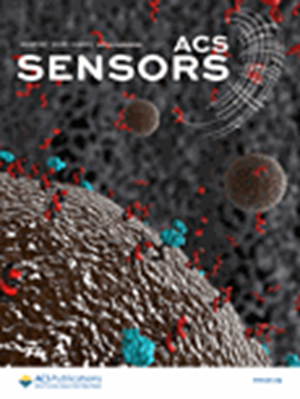Ultrasensitive and Selective Detection of Dopamine Through Substituent-Regulated Evolution of Quantum Defects.
IF 8.2
1区 化学
Q1 CHEMISTRY, ANALYTICAL
引用次数: 0
Abstract
Accurate detection and analysis of biomolecules like dopamine (DA) are vital for monitoring human health, particularly given DA's critical roles in a lot of medical disorders such as depression, Parkinson's and Alzheimer's diseases, and myopia. DA is often found at very low concentrations within certain body fluids, making it a challenging yet essential target for detection. This study presents an innovative and ultrasensitive detection methodology based on a quantum system, characterized by its exceptional sensitivity, selectivity, and linearity. By leveraging the unique quantum defect emission from semiconducting single-walled carbon nanotubes (SWCNTs) in the near-infrared II region, our approach effectively detects DA with high sensitivity, within the physiologically relevant range of nanomolar, and a detection limit as low as 1 nM. The sensing system maintains performance in phosphate-buffered saline and human urine environments. The interaction between aryldiazonium salts and DA that generates sp3 defects on the SWCNTs surface, regulated by specific substituents on the benzene ring, dictates the sensor's performance, ensuring superior selectivity against biologically relevant molecules. These advancements hold great potential for early disease detection, prevention, and treatment, marking an important advance in the field of biomedical diagnostics and nanosensor research.通过取代基调控的量子缺陷进化超灵敏和选择性检测多巴胺。
多巴胺(DA)等生物分子的准确检测和分析对于监测人类健康至关重要,特别是考虑到DA在许多医学疾病如抑郁症、帕金森病和阿尔茨海默病以及近视中起着关键作用。DA通常在某些体液中以非常低的浓度存在,使其成为具有挑战性但必不可少的检测目标。本研究提出了一种基于量子系统的创新超灵敏检测方法,其特点是具有卓越的灵敏度、选择性和线性。通过利用半导体单壁碳纳米管(SWCNTs)在近红外II区独特的量子缺陷发射,我们的方法以高灵敏度有效地检测到DA,在生理相关的纳摩尔范围内,检测限低至1 nM。传感系统在磷酸盐缓冲盐水和人类尿液环境中保持性能。芳基重氮盐和DA之间的相互作用在SWCNTs表面产生sp3缺陷,由苯环上的特定取代基调节,决定了传感器的性能,确保了对生物相关分子的优越选择性。这些进展对疾病的早期检测、预防和治疗具有巨大的潜力,标志着生物医学诊断和纳米传感器研究领域的重要进展。
本文章由计算机程序翻译,如有差异,请以英文原文为准。
求助全文
约1分钟内获得全文
求助全文
来源期刊

ACS Sensors
Chemical Engineering-Bioengineering
CiteScore
14.50
自引率
3.40%
发文量
372
期刊介绍:
ACS Sensors is a peer-reviewed research journal that focuses on the dissemination of new and original knowledge in the field of sensor science, particularly those that selectively sense chemical or biological species or processes. The journal covers a broad range of topics, including but not limited to biosensors, chemical sensors, gas sensors, intracellular sensors, single molecule sensors, cell chips, and microfluidic devices. It aims to publish articles that address conceptual advances in sensing technology applicable to various types of analytes or application papers that report on the use of existing sensing concepts in new ways or for new analytes.
 求助内容:
求助内容: 应助结果提醒方式:
应助结果提醒方式:


